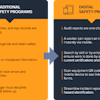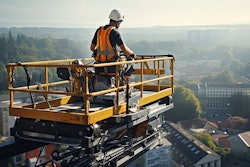
When it comes to head protection, workers and safety professionals alike typically think they know the difference between hard hats, safety helmets, climbing helmets, and bump caps. But a new study conducted by J.J. Keller & Associates, Inc., and the International Safety Equipment Association (ISEA) shows that there’s actually a lot of confusion, and that can be dangerous. Using the wrong kind of head protection, or using it improperly, can lead to a higher risk of traumatic brain injuries or fatalities on the job.
While 72% of respondents in our study believed they understood the differences between hard hats and safety helmets, the data showed otherwise. There’s a lack of accurate understanding about the difference between Type I and Type II head protection, and about the ANSI/ISEA Z89.1 and EN 12492 standards.
For example, nearly six out of 10 respondents erroneously thought safety helmets always offer more protection than hard hats. Respondents commonly made statements like “helmets are always safer” (not true), “hard hats don’t have modern features” (not true), and “EN 12492 offers more protection than Z89.1” (also not true).
Eight out of 10 respondents thought that only helmet-style head protection offered impact protection on the top, sides, front, and back. That is incorrect. This level of protection (referred to as Type II) can be offered in both hard hat and helmet styles.
Misconceptions Have Consequences
What’s the risk of this confusion? Failing to separate fact from fiction about head protection can be as fatal as not wearing it at all. The risks are all too real: The Bureau of Labor Statistics reports that U.S. workers experienced 195,720 head injuries from 2021-2022, with 684 fatalities in 2022 alone.
But here’s the kicker: Fewer than half of workers who experienced fall-related head injuries were wearing any type of head protection.
Despite the very real risks, it’s hard to change human behavior. Our study revealed that workplace safety professionals face four big head-protection challenges:
Getting employees to wear it correctly: Only 15% of respondents reported that head protection is worn correctly 100% of the time, showing that there is room for improvement, particularly in ongoing training and compliance programs. (The study also found that only half of respondents train workers on how to maintain their head protection.)
Enforcement: Respondents expressed difficulty enforcing the use of head protection among employees.
Comfort/Fit: Even though there are a lot of head protection options available on the market, respondents struggle to find head protection that is comfortable and fits their employees properly.
Heat-related concerns: With record-breaking temperatures these past few years, it’s no surprise that heat is causing employees to sometimes remove their head protection while on the job — or to not wear it in the first place.
Education and Training Needed
A construction site can be an unforgiving environment. Misconceptions, confusion, and enforcement problems around head protection all add up to a more dangerous workplace. The antidote: Better and more frequent education and training.
To help save lives and prevent injuries, ISEA offers comprehensive but easy-to-understand guidance about head protection on our website. It’s all free. Simply visit safetyequipment.org/head-protection for a gateway to helpful insights, including a buyers’ guide and a “know the facts” page.
This online resource:
● Offers a video in which experts explain the importance of wearing head protection to prevent traumatic brain injuries among construction workers and how to choose the right protection.
● Explains the key differences between Type I and Type II protection.
● Walks users through 10 common myths and misconceptions.
● Allows anyone to get a copy of ANSI/ISEA Z89.1-2014 R2019, the American National Standard for Industrial Head Protection.
● Explains the importance of actually reading the label on each product to move past marketing hype.
● Addresses the standards-based types of head protection and outlines their testing requirements.
● Provides links to additional resources and the latest news about head protection.
About the Study
The study drew responses from hundreds of EHS and safety professionals, 90% of whom were involved in making decisions related to head protection.
● The largest percentage of respondents (26%) came from construction companies.
● Manufacturing companies were a very close second, at 25%.
● The remaining 49% of respondents were split among a number of industries, including “other,” transportation, and utilities.
● Most worked for small- to medium-sized companies, with 67% working for companies with 10–500 employees.
● Only 28% of respondents hailed from companies with 500+ employees.
As Bob Larsen, Vice President of Research & Development with J. J. Keller, said after we completed our work: “We believe that the findings of this study will inspire meaningful discussions among regulators, safety professionals, and industry experts, and ultimately contribute to enhanced worker safety and well-being.”
New Bump Cap Standard
In addition to studying head protection practices, ISEA is introducing a new standard that will add clarity specifically about bump caps — which are not to be confused with hard hats or safety helmets.
Use of bump caps (which may include inserts and other styles) is common in workplaces where spaces are tight and workers are in close proximity to equipment and accessories, to prevent injuries such as contusions, lacerations, and bruises.
Bump caps aren’t intended to provide protection from hazards caused by falling or moving objects. They’re designed to reduce the amount of force transmitted to the wearer from worker-generated impacts to objects. They can’t provide complete head protection from severe impact and penetration.
The new standard — ISEA 100 — will include detailed guidance on instructions and marking, specifying that each bump cap shall be accompanied by manufacturers' instructions explaining the application(s) of use, proper method of size adjustment and fitting (including, if applicable, reverse wearing) and, guidelines for care and inspection.
Making Safety a Priority
Head protection has been a cornerstone of workplace safety for decades. The good news is, there have never been more head protection options than there are today. But our study clearly shows that urgent action is needed to address misconceptions and misinformation about this vital equipment.
With the rising number of head injuries in the workplace, the stakes are too high to ignore these critical gaps in understanding. It’s time to prioritize proper head protection to better protect our workforce.



















